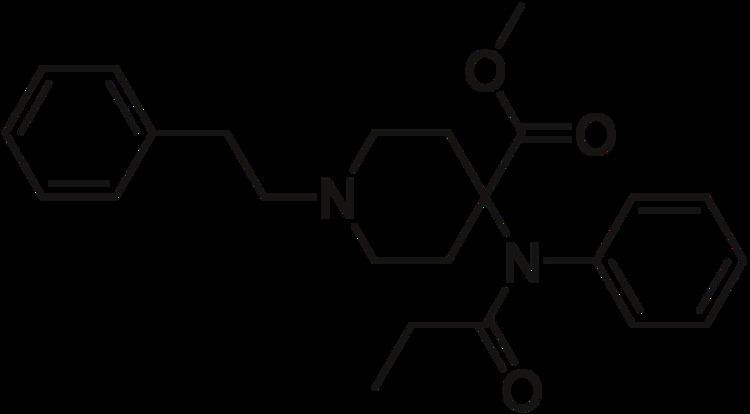Trade names Wildnil Biological half-life 7.7 hrs PubChem CID 62156 CAS ID 59708-52-0 | ATC code none CAS Number 59708-52-0 Molar mass 394.514 g/mol | |
 | ||
Legal status AU: S8 (Controlled)CA: Schedule IDE: Anlage I (Controlled)UK: Class AUS: Schedule IIIn general: ℞ (Prescription only) | ||
Vice news tonight the risk of carfentanil
Carfentanil or carfentanyl (also known as 4-carbomethoxyfentanyl) is an analog of the synthetic opioid analgesic fentanyl. It is 10,000 times more potent than morphine, making it among the most potent commercially used opioids. Carfentanil was first synthesized in 1974 by a team of chemists at Janssen Pharmaceutica which included Paul Janssen. It is marketed under the trade name Wildnil as a general anaesthetic agent for large animals, such as elephants.
Contents
- Vice news tonight the risk of carfentanil
- Carfentanil the next deadly street drug
- Moscow theater hostage crisis
- References
Side effects of carfentanil are similar to those of fentanyl, which include itching, nausea and respiratory depression, which can be life-threatening. Fentanyl analogs have killed hundreds of people throughout Europe and the former Soviet republics since the most recent resurgence in use began in Estonia in the early 2000s, and novel derivatives continue to appear.
Carfentanil is classified as Schedule II under the Controlled Substances Act in the United States with a DEA ACSCN of 9743 and a 2016 annual aggregate manufacturing quota of 19 grams.
In 2016, carfentanil was identified as an additive in heroin sold in Ohio, leading to a spike in the number of overdose cases.
Carfentanil the next deadly street drug
Moscow theater hostage crisis
A 2012 study found evidence supporting the claim that during the 2002 Moscow theater hostage crisis, the Russian military made use of an aerosol form of carfentanil and another similar drug, remifentanil, to subdue Chechen hostage takers. Its short action, easy reversibility and therapeutic index (10,600 vs. 300 for fentanyl) would make it a potential agent for this purpose. Riches, et al., found evidence from liquid chromatography-tandem mass spectrometry analysis of extracts of clothing from two British survivors, and urine from a third survivor, that the aerosol contained a mixture of the two anesthetics, the exact proportions of which the study was unable to determine. Previously, Wax et al. had surmised from the available evidence that the Moscow emergency services had not been informed of the use of the agent, but were instructed to bring opioid antagonists. Because of the lack of information provided, the emergency workers did not bring adequate supplies of naloxone or naltrexone (opioid antagonists) to prevent complications in many of the victims and there were subsequently over 125 confirmed deaths from both respiratory failure and aerosol inhalation during the incident. Assuming that carfentanil and remifentanil were the only active constituents, which has not been verified by the Russian military, the primary acute toxic effect to the theater victims would have been opioid-induced apnea; in this case mechanical ventilation or treatment with opioid antagonists could have been life-saving for many victims.
